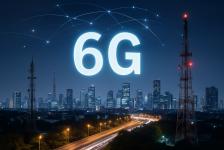Japanese scientists have developed the world's fastest internet. They reached 402 Tbps for the first time
Japanese scientists have achieved a new world record in internet speed, reaching 402 terabits per second. The result is 1.6 million times faster than the average internet speed in the USA. To achieve this result, they used commercially available optical fiber and a combination of various technologies. Although the speed was achieved only in laboratory conditions, the research is expected to help further develop optical networks.

Imagine if you could download the entire Netflix library in just a second. Does it sound like sci-fi? For Japanese scientists, it's reality. A team of researchers from the National Institute of Information and Communications Technology (NICT) in Japan recently achieved an incredible milestone in internet connection speed.
A speed that will take your breath away
Japanese scientists set a new world record in data transfer speed, a staggering 402 terabits per second (Tbps). For comparison, such a connection is 1.6 million times faster than the average broadband speed in the USA. At such a speed, you could download about 12,500 movies in a single second.
The key to success was using commercially available optical fiber and a smart combination of various technologies. Researchers employed all transmission bands of standard optical fibers and deployed various amplification technologies. This allowed them to unlock the potential of previously unused wavelengths.
What does this mean for the future of the internet?
NICT sees great potential in this advancement for expanding the capacity of optical communication infrastructure. With the growing demand for data services, this technology could significantly contribute to meeting the increasingly high demands for internet connections in the future.
However, before this astonishing speed reaches our homes, many hurdles need to be overcome. Although the record was achieved with regular optical fiber, it was under optimal laboratory conditions. Translating this success into a real-world application will require further research and resources.
For comparison, the average broadband speed in the USA in May 2024 was 248.27 Mbps for downloads and 34.23 Mbps for uploads. The fastest provider, Cox, achieved the highest average speed in the fourth quarter of 2023. The difference between these regular speeds and the Japanese record is, therefore, truly astronomical.
Although the path to practical use of the new technology is still long, this breakthrough gives us a fascinating glimpse into the future of the internet. Who knows, maybe one day we will all be surfing online at speeds we can't even dream of today.
What will 6G internet bring – lightning-fast connection, smart cities, and artificial intelligence in the network

Mobile networks of the sixth generation will push the boundaries of communication and data transmission. 6G internet will offer speeds in the order of terabits, minimal delay, and integration with artificial intelligence. In the article, we explain how this technology works, how it differs from 5G, what frequencies it uses, and why it is essential for smart cities and modern industry.
Wireless charging: What are its benefits, limitations, and where is it heading?

Wireless charging has evolved from a luxury feature to a standard part of most modern phones. Simply place your mobile on the pad, and energy begins to flow without searching for a cable and connector. We explain how wireless charging works, what it entails, and why Qi and Qi2 technologies have become the new standard of convenience.
What is Wi-Fi 7? What changes does it bring and when does it make sense to switch

Today's home Wi-Fi network is under increasing pressure. It has to handle video calls, online gaming, and dozens of smart devices. The new Wi-Fi 7 standard offers a solution that takes wireless connectivity to the next level. We'll explain what this standard means in practice and why it might be crucial for the future of home and business networks.
What is DNS? Everything you need to know about its functionality and setup

When you type a website address into the browser, the correct page loads in an instant. This is managed by the DNS system, without which the internet as we know it would not exist at all. In this article, you will learn what DNS is, how it works, what types of records it contains, and why it is important for both speed and security of the connection.
How does fiber optic internet work and what do you need for its installation?

Fast and stable connection is a basic necessity in every household today. The solution is fiber optic internet, which works differently than regular cables and offers greater reliability to users. We'll explain how this technology works in practice, what it entails to run a fiber optic cable to your home, and what equipment you’ll need to keep everything running smoothly.
Cloud gaming – the end of consoles in sight?

Cloud gaming allows you to play games from anywhere without the need for expensive hardware. In this article, you'll learn how game streaming works, what advantages and limitations it brings, and which services are leading the way today. And most importantly: can it really threaten traditional consoles?